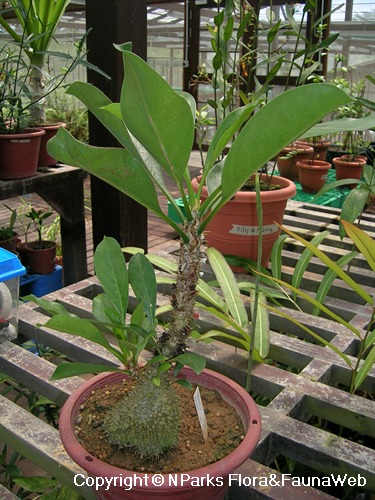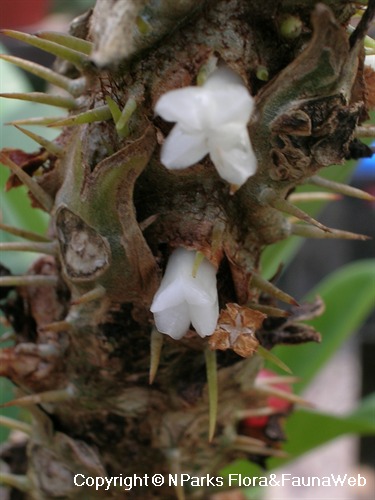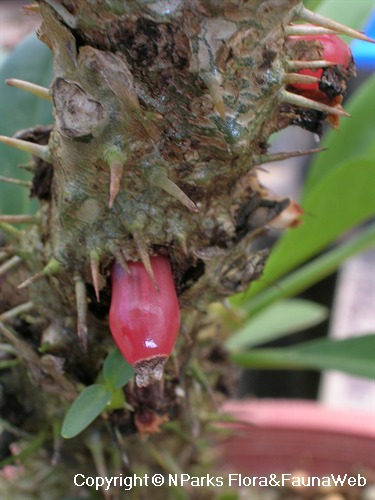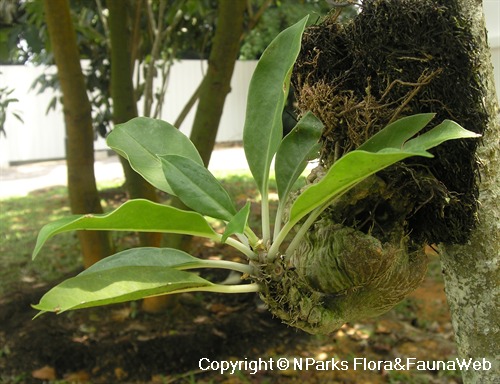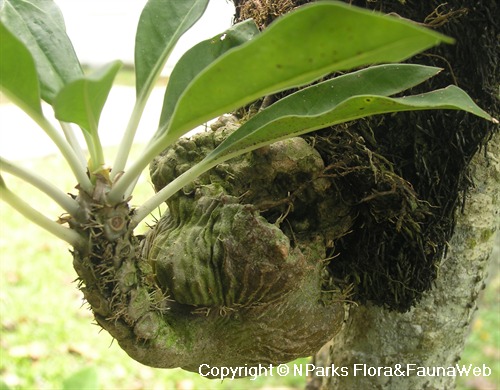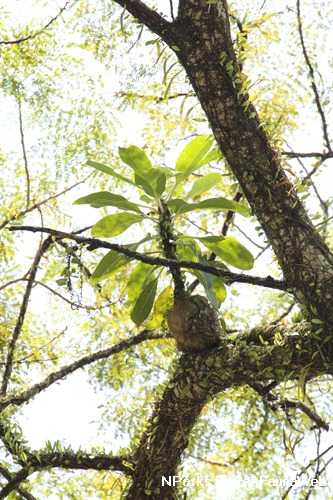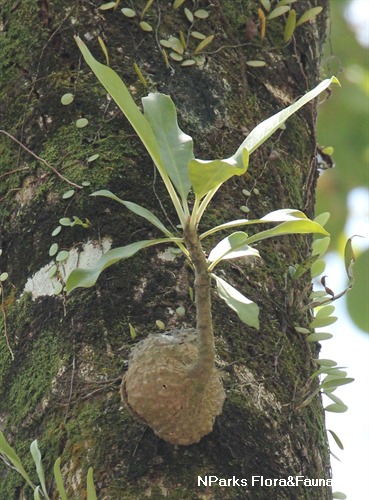
Back
Myrmecodia tuberosa Jack
| Family Name: | Rubiaceae |
| Synonyms: | Myrmecodia armata DC., Myrmecodia echinata Gaud., Myrmecodia rumphii Becc. |
| Common Name: | Ant Plant, Periuk Hantu, Perutak, Sembuku |
Name
Classifications and Characteristics
| Plant Division | Angiosperms (Flowering Seed Plants) (Dicotyledon) |
|---|---|
| Plant Growth Form | Shrub, Epiphyte |
| Lifespan (in Singapore) | Perennial |
| Mode of Nutrition | Autotrophic |
| Maximum Height | 0.4 m |
Biogeography
| Native Distribution | From Southeast Asia to the Solomon Islands, and northern Australia |
|---|---|
| Native Habitat | Terrestrial (Primary Rainforest, Mountain, Secondary Rainforest, Monsoon Forest, Coastal Forest, Freshwater Swamp Forest, Riverine), Shoreline (Mangrove Forest) |
| Preferred Climate Zone | Tropical, Sub-Tropical / Monsoonal |
| Local Conservation Status | Native to Singapore (Presumed Nationally Extinct (NEx)) |
Description and Ethnobotany
| Growth Form | It is an epiphytic shrub, with stems arising from a swollen tuberous base. The tubers are irregularly round to oblong, up to 40 by 15 cm, and usually with prickles on the outer surface and inner cavities within the tubers. |
|---|---|
| Foliage | Its opposite, stalked leaves have thinly leathery leaf blades that are elliptic to narrowly drop-shaped or spatula-shaped and 7.6–47 by 2.5–14 cm. |
| Flowers | Its flowers are bisexual, white, each with 4 petals, and develop in few-flowered clusters that are sunken into the stem. |
| Fruit | Its fruit is a fleshy drupe that is yellow, orange-red to pink when ripe, egg-shaped to somewhat round, and about 7 mm long. |
| Habitat | It usually grows on trees in mangrove forests along the coast, in lowland to montane, swamp, and riverine forests, up to 2500 m altitude. |
| Associated Fauna | The cavities of its tubers are inhabited by ants. The flowers are most probably pollinated by ants. The seeds are also dispersed by ants, as well as small frugivorous birds. |
| Cultivation | It can be propagated by seed. |
| Etymology | Myrmecodia, from the Greek word myrmekodes, full of ants; Latin tuberosa, with tubers, referring to the swollen base of the stem of this species |
| Ethnobotanical Uses | Medicinal: The tuber can be pounded and used as a poultice to treat swellings and headache. Others: It is cultivated as an ornamental plant. |
Landscaping Features
| Landscaping | It may be suitable for parks and roadsides as it is an interesting epiphyte that can be grown on trees. |
|---|---|
| Desirable Plant Features | Ornamental Form |
| Landscape Uses | Parks & Gardens, Small Gardens, Coastal, Beachfront / Shoreline, Skyrise / Balcony, Suitable for Hanging Baskets, Suitable for Bonsai |
| Usage Hazard - Cons | Spines/Thorns - Stem/Branch |
| Usage Hazard - Cons Remarks | Swollen stems inhabited by ants, which may bite while defending the plant which they live in. |
Fauna, Pollination and Dispersal
| Fauna Pollination Dispersal Associated Fauna | Bird-Attracting |
|---|---|
| Pollination Method(s) | Biotic (Fauna) |
| Seed or Spore Dispersal | Biotic (Fauna) |
Plant Care and Propagation
| Light Preference | Semi-Shade, Full Sun |
|---|---|
| Water Preference | Little Water, Occasional Misting |
| Rootzone Tolerance | Shallow Media |
| Maintenance Requirements | Moderate |
| Propagation Method | Seed |
Foliar
| Foliage Retention | Evergreen |
|---|---|
| Mature Foliage Colour(s) | Green |
| Mature Foliage Texture(s) | Leathery, Thin |
| Foliar Type | Simple / Unifoliate |
| Foliar Arrangement Along Stem | Opposite |
| Foliar Attachment to Stem | Petiolate |
| Foliar Shape(s) | Non-Palm Foliage (Obovate, Elliptical, Spathulate) |
| Foliar Venation | Pinnate / Net |
| Foliar Margin | Entire |
| Leaf Area Index (LAI) for Green Plot Ratio | 4.5 (Shrub & Groundcover - Dicot) |
Non - Foliar and Storage
| Stem Type & Modification | Caudex |
|---|
Floral (Angiosperm)
| Flower & Plant Sexuality | Bisexual Flowers |
| Flower Colour(s) | White |
|---|---|
| Flower Grouping | Cluster / Inflorescence |
| Flower Location | Axillary |
| Flower Symmetry | Radial |
Fruit, Seed and Spore
| Mature Fruit Colour(s) | Red, Orange, Pink, Yellow / Golden |
|---|---|
| Fruit Classification | Simple Fruit |
| Fruit Type | Fleshy Fruit , Non-Accessory Fruit |
Image Repository
Others
| Master ID | 961 |
|---|---|
| Species ID | 2255 |
| Flora Disclaimer | The information in this website has been compiled from reliable sources, such as reference works on medicinal plants. It is not a substitute for medical advice or treatment and NParks does not purport to provide any medical advice. Readers should always consult his/her physician before using or consuming a plant for medicinal purposes. |

